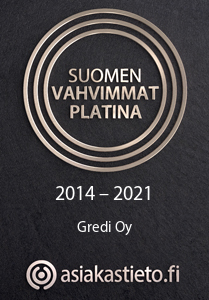
DYNAMIC TEMPLATES AND ALL BRAND MATERIALS IN
THE SAME CLOUD SERVICE SPEED UP WORK
Dream. Dare. This is a wonderful invitation from the University of Jyväskylä on their website! The University of Jyväskylä, founded as a teacher seminary in 1863, is in the top 3% in the rankings of all universities in the world and represents the world’s top in many disciplines. The University of Jyväskylä serves 14,000 students, employs 2,600 professionals, offers more than 100 programmes and has produced thousands of publications. The university has the faculties of Humanities and Social Sciences, Educational Sciences and Psychology, Mathematics and Natural Sciences, Sports Science and Information Technology, as well as the School of Economics. For continuous learning it provides Open University, for example.
A lot to deal with in terms of brand management. To tackle the challenge, the University of Jyväskylä introduced digital brand and asset management service Gredi Content HUB to make the job easier for the whole community.
Why did you start to use Content HUB?
Gredi Content HUB is a secure cloud service, one platform on which all materials are put together in a brand-controlled way for users to easily find and utilize them. The University of Jyväskylä started to utilize the service at a rapid pace.
“Dynamic templates were the most important thing for us. It was felt that they could facilitate internal workflows. Our goal was to be able to offer customizable materials to everyone, without the help of a graphic designer,” says Miikka Kimari, Communications Manager at the University of Jyväskylä.
“We are recruiting hundreds of people annually, and there are often dozens of recruiters at a time,” says Tarja Vänskä-Kauhanen, spokesperson for the University of Jyväskylä. “The most important partners in making dynamic templates for recruitment communications are the people in our HR department. We have found the dynamic templates to be very versatile! We are also noticing more needs all the time as we get better feel of Gredi’s service.”
“In distribution channels such as social media and elsewhere, dynamic brand-controlled templates support our distinction, discovery and visibility”
What does the Content HUB of the University of Jyväskylä contain?
The HUB created by Gredi bears the name “The University of Jyväskylä Data Bank”, and a lot of valuable material has been stored there for hard use!
Public materials can be browsed freely by anyone who is interested without any user identification. This material includes a guide for university applicants, for example. Photos of the personnel, annual reports and brochures are available to the media, all of which are freely available for journalistic purposes.
The internal service contains logos and graphic guidelines. There are ready-made templates for Word, PowerPoint, posters and brochures to make the work easier. Infographics can be found there too. There are pictures of people and different faculties. The service has plenty of dynamic templates for social media and recruitment ads. There you will also find presentations and brochures with language versions.
Search term video lists 55 items as a result. “In the world of marketing and communications, videos and rich content have come to stay. Gredi’s service is very good for storing large sized video files during filming, and for sharing finished videos as links,” says Miikka.
Who are the different users of the service?
To begin with, the marketing and communications people are the obvious users. Next, the faculties. Does it sound right?
“Currently the majority are internal users, i.e. employees from all over the university. And we already have some partners using the service. And of course the representatives of media,” Miikka lists.
Tarja extends the list of users. “The maintenance of our website is decentralized in terms of event production and subjects. The people responsible for them are able to take advantage of the features in Gredi’s service, such as cropping images which is possible without image editing programs.”
“In addition to the media, our external stakeholders also include large organisations with whom we work a lot, such as educational institutions in the area, the city and the hospital district,” says Tarja.
Tarja emphasizes the importance of taking user-friendliness into account already in the data storage phase. “Good archiving to ensure easy retrieval is an important ongoing project. Likewise, enriching the content with solid and relevant metadata.”
“The establishment of our new service and the transfer of data was a frictionless process. We have got great customer service from Gredi, and the service itself works well.”
Tarja continues to thanking Gredi. “It’s pretty smooth and witty! Gredi replies to our messages quickly and things move on as planned. They have given us new ideas about using new features, for example. We have also got ideas for new dynamic templates.”
“Our brand has to be managed so that the quality remains solid and desired, and that the content is diverse and rich,” Miikka and Tarja conclude.
“It is unique thing that we can admire the great campus designed by Alvar Aalto here in Jyväskylä! We have photographed our red and white brick buildings and the city from the corner of Seminaarinmäki on our campus in all four seasons,” says Tarja. Miikka reveals that the University of Jyväskylä area is currently being applied for as European Heritage Label, the first in Finland! “Respectively, this goal is also reflected in the quality and quantity of the images in our service,” Tarja smiles.






